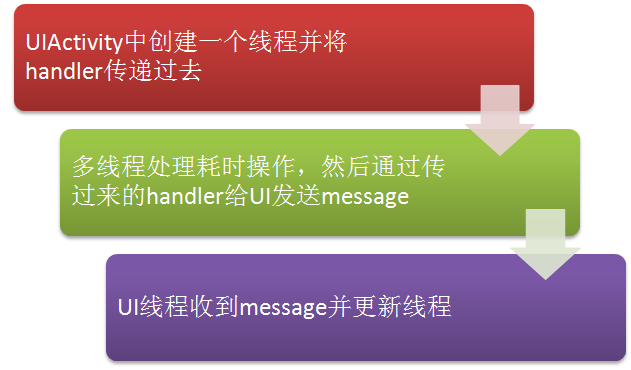編輯:Android開發實例
攔截短信有幾個關鍵點:
1.android接收短信時是以廣播的方式
2.程序只要在自己的Manifest.xml裡加有"接收"SMS的權限
view plaincopy to clipboardprint?
<uses-permission android:name="android.permission.RECEIVE_SMS"></uses-permission>
3.要寫個廣播接收類
view plaincopy to clipboardprint?
public
class smsreceiveandmask extends BroadcastReceiver {
private String TAG = "smsreceiveandmask";
@Override
public
void onReceive(Context context, Intent intent) {
}
4.Manifest.xml的receiver標簽裡要加入intent-filter ,action為
view plaincopy to clipboardprint?
<action android:name="android.provider.Telephony.SMS_RECEIVED" />
5.重要的是要在這個intent-filter上加上priority優先級,以使自己接收到SMS優先於系統或其它軟件
view plaincopy to clipboardprint?
<receiver android:name=".smsreceiveandmask" >
<intent-filter android:priority="1000">
<action android:name="android.provider.Telephony.SMS_RECEIVED" />
</intent-filter>
</receiver>
6.當自己的程序接收到要屏蔽的SMS後,用
this.abortBroadcast();來結束廣播的繼續發給別的程序,這樣系統就不會收到短信廣播了,Notification也不會有提示了
view plaincopy to clipboardprint?
// 第三步:取消
if (flags_filter) {
this.abortBroadcast();
}
源碼如下:
Manifest.xml
view plaincopy to clipboardprint?
<?xml version="1.0" encoding="utf-8"?>
<manifest xmlns:android="http://schemas.android.com/apk/res/android"
package="com.hwttnet.test.smsreceiveandmask" android:versionCode="1"
android:versionName="1.0">
<uses-sdk android:minSdkVersion="3" />
<uses-permission android:name="android.permission.RECEIVE_SMS"></uses-permission>
<application android:icon="@drawable/icon" android:label="@string/app_name">
<receiver android:name=".smsreceiveandmask" >
<intent-filter android:priority="1000">
<action android:name="android.provider.Telephony.SMS_RECEIVED" />
</intent-filter>
</receiver>
</application>
</manifest>
BroadcastReceiver類:
view plaincopy to clipboardprint?
package com.hwttnet.test.smsreceiveandmask;
import android.app.Activity;
import android.content.BroadcastReceiver;
import android.content.Context;
import android.content.Intent;
import android.os.Bundle;
import android.telephony.SmsMessage;
import android.util.Log;
public
class smsreceiveandmask extends BroadcastReceiver {
private String TAG = "smsreceiveandmask";
@Override
public
void onReceive(Context context, Intent intent) {
Log.v(TAG, ">>>>>>>onReceive start");
// 第一步、獲取短信的內容和發件人
StringBuilder body = new StringBuilder();// 短信內容
StringBuilder number = new StringBuilder();// 短信發件人
Bundle bundle = intent.getExtras();
if (bundle != null) {
Object[] _pdus = (Object[]) bundle.get("pdus");
SmsMessage[] message = new SmsMessage[_pdus.length];
for (int i = 0; i < _pdus.length; i++) {
message = SmsMessage.createFromPdu((byte[]) _pdus);
}
for (SmsMessage currentMessage : message) {
body.append(currentMessage.getDisplayMessageBody());
number.append(currentMessage.getDisplayOriginatingAddress());
}
String smsBody = body.toString();
String smsNumber = number.toString();
if (smsNumber.contains("+86")) {
smsNumber = smsNumber.substring(3);
}
// 第二步:確認該短信內容是否滿足過濾條件
boolean flags_filter = false;
if (smsNumber.equals("10086")) {// 屏蔽10086發來的短信
flags_filter = true;
Log.v(TAG, "sms_number.equals(10086)");
}
// 第三步:取消
if (flags_filter) {
this.abortBroadcast();
}
}
Log.v(TAG, ">>>>>>>onReceive end");
}
}
 Android中的Handler與多線程應用實例
Android中的Handler與多線程應用實例
本文首先解釋一下handler是用來干嘛的,然後通過例子介紹其在多線程中的應用。 什麼是Handler handler通俗一點講就是用來在各個進程之間發送數據的處
 Android JSON解析器
Android JSON解析器
JSON代表JavaScript對象符號。它是一個獨立的數據交換格式,是XML的最佳替代品。本章介紹了如何解析JSON文件,並從中提取所需的信息。Android提供了四個
 Android編程中TextView寬度過大導致Drawable無法居中問題解決方法
Android編程中TextView寬度過大導致Drawable無法居中問題解決方法
本文實例講述了Android編程中TextView寬度過大導致Drawable無法居中問題解決方法。分享給大家供大家參考,具體如下: 在做項目的時候,很多時候我們
 Android控件系列之Toast使用介紹
Android控件系列之Toast使用介紹
Toast英文含義是吐司,在Android中,它就像烘烤機裡做好的吐司彈出來,並持續一小段時間後慢慢消失Toast也是一個容器,可以包含各種View,並承載著它們